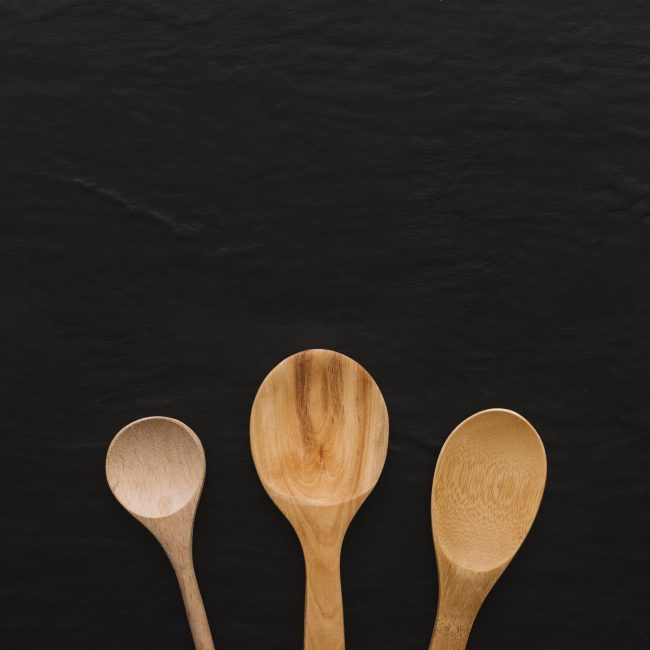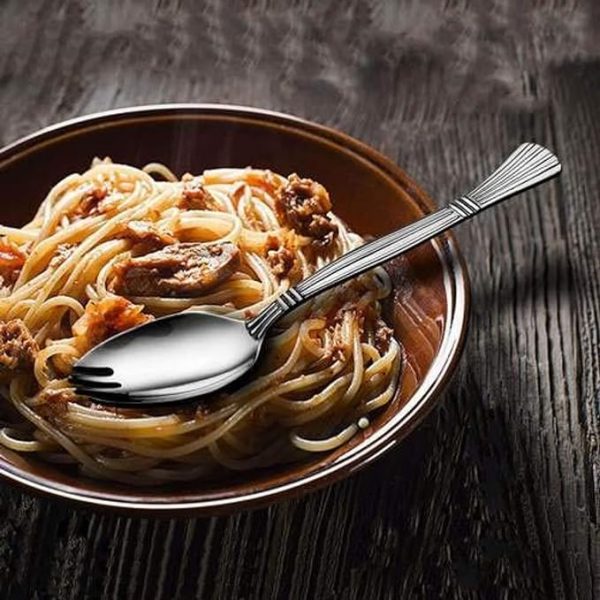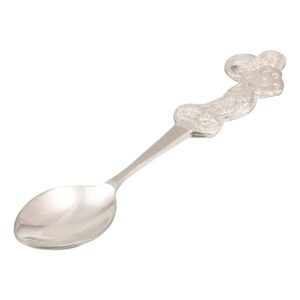“Unlocking the Types Of Cutlery With Pictures And Their Uses: Join Us on a Journey of Culinary Discovery!”

The Spoon is one of the oldest eating cutlery known to humanity, with its history dating back thousands of years. Typically consisting of a small, shallow bowl attached to a handle, spoons come in a variety of shapes, sizes, and materials, including metal, wood, plastic, and ceramic.
While the primary function of a spoon is to convey food from plate to mouth, its uses extend beyond mere practicality. Spoons are integral to various cultural practices and rituals worldwide. They symbolize nurturing, comfort, and hospitality, often associated with sharing meals and communal dining experiences.
Beyond their utilitarian purpose, spoons have also found their way into idiomatic expressions and literary references, reflecting their significance in human culture. Furthermore, spoons have been subjects of art and craftsmanship, with intricate designs and decorative elements.
Cutlery Saga: Tracing the Timeless Tale of Culinary Companion
The history of the cutlery is as old as human civilization itself, with archaeological evidence suggesting that primitive spoon-like utensils have been used for eating since prehistoric times. Here’s a brief overview of the history of the spoon:
1. Early Origins: The earliest spoons were likely made from natural materials such as shells, animal horns, or carved wood. These early utensils were simple in design and primarily served the function of scooping and conveying food to the mouth.
2. Ancient Civilizations: Spoons have been found in the archaeological remains of ancient civilizations such as Mesopotamia, Egypt, Greece, and Rome. These early spoons were often crafted from materials like bronze, silver, or gold and were sometimes ornately decorated, showcasing their significance in society.
3. Medieval Europe: During the Middle Ages, spoons became more widespread among the upper classes in Europe. They were often made of silver or pewter and were considered valuable possessions, sometimes even given as gifts or inherited heirlooms.
4. Renaissance and Beyond: The Renaissance period saw advancements in metallurgy and craftsmanship, leading to the production of more intricate and decorative spoons. As trade routes expanded, various regions developed their own styles of spoon design and manufacture.

5. Industrial Revolution: The Industrial Revolution brought about significant changes in the production of utensils, including spoons. Mass production techniques allowed for the widespread availability of inexpensive spoons made from materials such as stainless steel and aluminum.
6. Modern Times: In contemporary society, spoons remain an essential part of everyday life. They come in a wide range of designs and materials to suit different culinary needs and personal preferences. Additionally, modern manufacturing processes have enabled the production of specialized spoons for specific purposes, such as cooking, serving, and eating various types of food.
Throughout history, the spoon has evolved from a simple tool for eating into a symbol of cultural traditions, culinary innovation, and artistic expression. Its enduring presence in human society underscores its universal importance in the realm of food and dining.

Let's delve deeper into the topic of cutlery types:
1. Evolution of Design: Over time, spoon designs have evolved to accommodate different culinary needs and cultural preferences. For example, Asian cultures often use shorter and flatter spoons for eating rice and soups, while Western cultures typically favor deeper and more rounded spoons for soups and desserts.
2. Cultural Significance: In many cultures, the spoon holds symbolic significance beyond its practical use. For example, in Western wedding traditions, a “spooning” ceremony involves the newlyweds feeding each other a spoonful of cake as a symbol of their commitment to provide nourishment and care for one another.
3. Ritual and Ceremony: Spoons are integral to various rituals and ceremonies around the world. For instance, in Hindu weddings, the bride’s family presents the groom with a set of ceremonial spoons, known as “kumkum,” symbolizing the importance of food and hospitality in married life.

4. Artistic Expression: Spoons have inspired artists and artisans to create intricate and decorative designs. From hand-carved wooden spoons to intricately engraved silverware, spoons have been transformed into works of art that showcase craftsmanship and creativity.
5. Functional Innovations: Modern technology and materials have led to innovations in spoon design and functionality. For example, ergonomic handles, heat-resistant materials, and specialized coatings have enhanced the usability and durability of spoons for various cooking and serving tasks.
6. Health and Hygiene: In recent years, there has been increased awareness of the importance of hygiene and food safety, leading to the development of antimicrobial and dishwasher-safe spoons. These innovations help reduce the risk of bacterial contamination and ensure safe food handling practices.

7. Environmental Considerations: With growing concerns about plastic pollution and sustainability, there has been a resurgence of interest in eco-friendly and biodegradable spoon alternatives. Materials such as bamboo, cornstarch-based bioplastics, and stainless steel offer more sustainable options for disposable and reusable spoons.
8. Social and Psychological Aspects: The act of sharing a meal with others using spoons fosters social bonds and reinforces cultural traditions. Additionally, research suggests that the shape, weight, and texture of utensils, including spoons, can influence perceptions of food and dining experiences, highlighting the interconnectedness of sensory perception and culinary enjoyment.
By exploring these various aspects, we gain a deeper understanding of the multifaceted role that spoons play in human culture, history, and everyday life.
Let's Spoon! Exploring the Top Cutlery types You Need to Know:
1. Teaspoon: A small spoon used for stirring tea or coffee, as well as for measuring small quantities of ingredients in cooking and baking.
2. Tablespoon: Larger than a teaspoon, used for serving and eating food at the table. It’s also a standard unit of measurement in cooking, typically equivalent to about 15 milliliters.
3. Dessert Spoon: Slightly larger than a teaspoon, but smaller than a tablespoon, often used for eating desserts like pudding, yogurt, or ice cream.
4. Soup Spoon: Larger and rounder than a standard tablespoon, with a deeper bowl, designed for consuming soups and stews.
5. Bouillon Spoon: Similar to a soup spoon but with a rounder bowl and shorter handle, used specifically for consuming clear broth or bouillon.
6. Demitasse Spoon: A small, narrow spoon used for stirring and sipping espresso or other small, strong coffee drinks.
7. Caviar Spoon: A small, often ornate spoon made from a non-reactive material such as mother-of-pearl or stainless steel, used for serving caviar to avoid imparting metallic flavors.
8. Grapefruit Spoon: A spoon with a serrated edge on one side, specifically designed for scooping out sections of grapefruit or other citrus fruits.
9. Sugar Spoon: A small spoon with a shallow bowl, used for stirring sugar into beverages or for serving sugar from a sugar bowl.
10. Slotted Spoon: A spoon with slots or holes in the bowl, allowing liquids to drain when serving foods like vegetables, poached eggs, or fried foods.
11. Fork Spoon: Commonly known as a spork, is a hybrid utensil that combines the features of both a fork and a spoon. It typically has a spoon-like bowl on one end and tines or prongs resembling those of a fork on the other end.
12. Wooden Spoon: Commonly used in cooking and baking for mixing, stirring, and serving a wide range of foods, from sauces and soups to batters and doughs.
13. Silver Spoon: Typically refers to a spoon made of sterling silver or silver-plated metal.
Types Of Cutlery And Their Uses: Here Is A Video Explanation For You:
Cutlery Unleashed: Discover the Ultimate Stands & Sets Collection
- Spoon Sets: Typically include multiple spoons of various types, sizes, and designs, catering to different culinary needs and preferences. Spoon sets offer a convenient and comprehensive solution for stocking your kitchen with a variety of spoons for different cooking, serving, and dining needs. They provide both functionality and aesthetic appeal, enhancing the dining experience while complementing kitchen decor.
- Spoon Stand: Also known as a spoon holder or spoon rest, is a kitchen accessory designed to hold and store cooking or serving spoons when they are not in use. A spoon stand is a practical and functional kitchen accessory that helps keep cooking utensils organized, accessible, and tidy while cooking, thereby enhancing the cooking experience and streamlining kitchen tasks.
Crafting Magic with Cutlery: Innovative DIY Ideas!
Here are some creative ideas that incorporate the use of spoons:
1. Spoon Painting: Use spoons as unconventional painting tools. Dip the bowl of the spoon into paint and create unique textures and patterns on canvas or paper by pressing, dragging, or swirling the spoon.
2. Spoon Plant Markers: Repurpose old spoons by turning them into plant markers for your garden. Write the names of different plants on the handles of the spoons and stick them into the soil next to each corresponding plant.
3. Spoon Candle Holders: Glue or attach several spoons together in a circular arrangement to create a decorative candle holder. Place a small candle in the center for a unique centerpiece or tabletop decoration.
4. Spoon Jewelry: Turn vintage or decorative spoons into unique pieces of jewelry. Flatten the bowls of the spoons with a hammer, polish them to a shiny finish, and attach them to chains or cords to create one-of-a-kind necklaces or bracelets.
5. Spoon Stamping: Use the handle or bowl of a spoon as a stamp for creating patterns on fabric, paper, or other surfaces. Dip the spoon in paint or ink and press it onto the desired surface to create unique designs and textures.
These ideas demonstrate the versatility of spoons beyond their traditional culinary use, offering creative and innovative ways to incorporate them into various crafts and projects.
In conclusion, the spoon, often overlooked in its simplicity, reveals itself to be an indispensable tool with a rich history and endless possibilities. From its ancient origins to its modern-day innovations, the spoon has played a vital role in shaping culinary culture and human civilization.
As we’ve explored various types of spoons, from the classic teaspoon to the specialized grapefruit spoon, and discovered creative uses for spoons beyond the kitchen, it becomes evident that this seemingly ordinary utensil is anything but mundane.
Whether it’s savoring a comforting bowl of soup on a chilly evening, stirring up a batch of homemade cookies with loved ones, or embarking on creative DIY projects using spoons as the canvas, the spoon continues to bring joy, nourishment, and inspiration to our lives.
So, the next time you pick up a spoon, take a moment to appreciate its simplicity, versatility, and enduring significance. Whether you’re stirring, serving, or crafting, remember that the spoon is more than just a utensil—it’s a symbol of connection, creativity, and the art of everyday living
Here are some frequently asked questions (FAQs) about Spoons:
1. What are the different types of cutlery?
There are various types of cutlery, including teaspoons, tablespoons, soup spoons, dessert spoons, grapefruit spoons, and serving spoons, each serving different culinary purposes.
2. What materials are cutlery made from?
Cutlery can be made from a variety of materials, including stainless steel, silver, plastic, wood, bamboo, ceramic, and melamine, each offering different qualities in terms of durability, aesthetics, and suitability for specific uses.
3. How do you clean and care for cutlery?
Cutlery can typically be washed by hand with mild soap and water or placed in the dishwasher for cleaning, depending on the material. It’s essential to dry them promptly to prevent water spots and tarnishing. For wooden spoons, it’s best to hand wash them and periodically oil them to maintain their condition.
4. Is cutlery recyclable?
Many spoons made from materials like stainless steel, silver, and certain types of plastic can be recycled.Single-use plastic spoons may not be recyclable in all areas and should be disposed of properly.In any case, it’s crucial for actually take a look at neighborhood reusing rules to guarantee legitimate removal.
5. What is the origin of the phrase “born with a silver spoon in their mouth”?
The phrase “born with a silver spoon in their mouth” refers to someone who is born into wealth and privilege. It originated from the practice of wealthy families giving silver spoons as christening gifts to newborn babies, symbolizing their privileged status from birth.






















